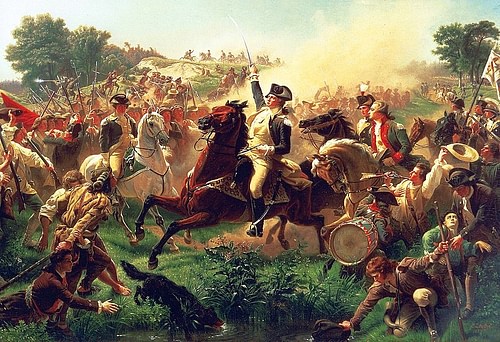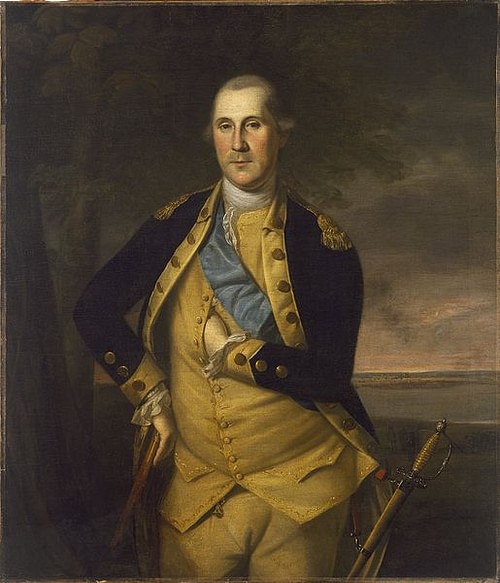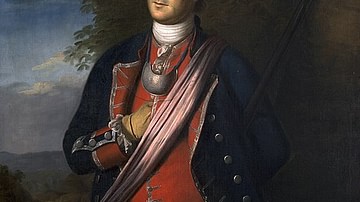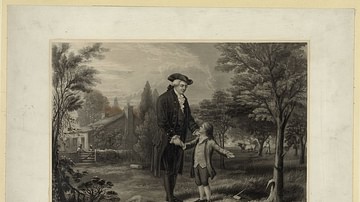
George Washington (1732-1799) was an American military officer and statesman who led the Continental Army to victory during the American Revolutionary War (1775-1783) and served as the first president of the United States (1789-1797). Often regarded as the 'Father of His Country', Washington remains one of the most revered and iconic figures in US history.
Early Life
George Washington was born at 10 am on 22 February 1732 at Pope's Creek plantation in Westmoreland County, Virginia. He was the first of six children born to Augustine Washington, a wealthy Virginian landowner, and his second wife Mary Ball Washington; George also had four older half-siblings from his father's first marriage. Little is known about George's childhood. His early years were mostly spent on the family property of Ferry Farm on the Rappahannock River, and he likely attended school in Fredericksburg, Virginia, where he excelled in the subjects of geometry, trigonometry, and mapmaking. When his father suddenly died in 1743, 11-year-old George inherited Ferry Farm as well as ten enslaved people. Too young to fend for himself, he went to live with his eldest half-brother, Lawrence Washington (b.1718), at Mount Vernon. George idolized Lawrence, who he came to regard as both a father figure and a best friend.
George's aptitude for mathematics led him to consider a career as a land surveyor, a respectable path to wealth and social advancement. In 1748, at the age of 16, he embarked on his first expedition into the Shenandoah Valley to survey the property of his influential neighbor, Thomas Fairfax. The next year, he earned his surveyor's license and, through Fairfax's patronage, was appointed surveyor for Culpeper County. Over the next three years, Washington completed 200 surveying expeditions and measured a total of 60,000 acres along Virginia's western frontier. But just as George's career was taking off, Lawrence came down with tuberculosis. In November 1751, he went to the Caribbean island of Barbados in the hopes that the tropical air would improve his condition. George accompanied him, and contracted a painful case of smallpox during his brief stay on the island. George soon recovered but Lawrence was not so lucky, as he died shortly after returning to Virginia in 1752. After his brother's death, George started leasing Mount Vernon from Lawrence's widow and became the legal owner of the property after her own death in 1761.
In 1753, George Washington reached the age of maturity, and was eager to find a way to make a name for himself. He would soon have an opportunity. The French had begun to construct forts on the forks of the Ohio River, fertile territory that had been claimed by Virginia. In November, Washington was sent as an envoy to demand that the French vacate the Ohio Country at once. On his journey into the west, he was joined by Christopher Gist, an experienced frontiersman and guide, and Tanacharison, a Mingo chieftain called the 'Half-King' by Virginians. It was Tanacharison who gave Washington the Seneca name of 'Conotocaurius' or 'Devourer of Villages', in reference to Washington's great-grandfather, who had helped expel Native Americans from their lands in Virginia. The small party reached the French Fort LeBoeuf during a snowstorm; although they were received cordially by the fort's commander, Washington's demands were firmly rebuffed. Washington then embarked on his trek back to Virginia which included several perilous episodes. While crossing the icy Alleghany River in a raft, Washington fell overboard, and likely would have drowned had Gist not pulled him from the water.

French and Indian War
In April 1754, Washington was commissioned as a lieutenant colonel in the newly formed Virginia Regiment and was sent back to the Ohio Country, this time with a company of 159 men, to again demand that the French leave. He set up camp in a grassy field called Great Meadows, where he was informed by one of Tanacharison's scouts that a party of French soldiers was encamped nearby. Early in the morning of 28 May 1754, Washington and Tanacharison ambushed the French camp; in the short skirmish that followed, several French troops were killed, including their commander, Joseph Coulon de Jumonville. Washington immediately withdrew back to Great Meadows, where his men hastily constructed Fort Necessity. But when the French attacked on 3 July, the fort was unable to hold out; after eight hours of fighting, Washington agreed to surrender on the condition that his surviving men could return to Virginia. The incident greatly heightened tensions between Britain and France, helping to spark a global conflict, the Seven Years' War (1756-1763).
The next year, Brigadier General Edward Braddock landed in Virginia with two regiments of British regulars, tasked with capturing Fort Duquesne and forcing the French from the Ohio Country once and for all. When Braddock's Expedition set out in May 1755, Washington accompanied it as one of Braddock's aides-de-camp, but was forced to remain behind for much of the campaign on account of his dysentery. He was, however, with the army when it was ambushed by the French and their Indigenous allies on 9 July at the Battle of the Monongahela. Despite having two horses killed from under him, Washington managed to rally the panicked British army and help lead the retreat. Over 800 British and provincial soldiers had become casualties in the ambush including Braddock, who was mortally wounded. Over the next two years, Washington, now a full colonel in command of the Virginia Regiment, oversaw the defense of the colony's western frontier. In 1758, he joined the Forbes Expedition which succeeded in capturing Fort Duquesne without firing a shot. This campaign helped turn the tide of the French and Indian War, which ultimately resulted in a British victory in 1763.
Marriage & Plantation Life
Frustrated that his exploits had not won him a commission in the regular British army, Washington resigned from the Virginia Regiment and returned to Mount Vernon. He won election to the House of Burgesses in 1758 and, the following January, married the wealthy widow Martha Dandridge Custis. The marriage gave Washington control over the 18,000-acre Custis estate as well as 84 enslaved people, making him one of the most influential landowners in Virginia. He and Martha never had any children together; indeed, some scholars have speculated that Washington's 1751 bout with smallpox rendered him sterile. Instead, Washington treated Martha's children from her first marriage, John Parke Custis and Martha 'Patsy' Parke Custis, as if they were his own. Sadly, he would outlive them both; Patsy died of an epileptic seizure in 1773 at the age of 17, while John died of 'camp fever' in 1781 while serving at Yorktown. After their deaths, Washington found joy in raising John's children.
Washington spent the 1760s tending to his beloved home of Mount Vernon, where wheat and tobacco were grown and harvested by hundreds of slaves; over the course of Washington's lifetime, 577 enslaved people lived and worked at Mount Vernon. Although Washington was not considered a cruel slaveowner by the standards of the day, his slaves often had to subsist on insufficient rations, live in cramped, one-room dwellings, and exist perpetually under the supervision of Washington's overseers; Washington also had no qualms about whipping or selling enslaved people who tried to run away. Washington's views on the institution of slavery evolved over time and, by the advent of the Revolution, he found the practice to be abhorrent. Nevertheless, he did little to work toward the abolition of slavery and, indeed, continued to rent and purchase slaves until his death.
As Washington concerned himself with his life at Mount Vernon, tensions between Britain and the Thirteen Colonies were escalating. Disagreement over the colonists' rights and liberties – expressed over the constitutional authority of Parliament to issue tax policies like the Stamp Act and Townshend Acts, policies which the colonists had never consented to – led to riots and incidents of violence like the Boston Massacre (1770). Washington increasingly sided against Parliament; his status as one of Virginia's leading citizens automatically made him a leader in the colony's Whig, or Patriot, movement. In 1774, he attended the First Continental Congress in Philadelphia and helped train Virginia militias for potential conflict with British soldiers. When, on 19 April 1775, blood was spilled at the Battles of Lexington and Concord, Washington was prepared to fight for his homeland.
Commander-in-Chief
On 14 June 1775, the Second Continental Congress adopted the Continental Army and nominated Washington as its commander-in-chief; their decision was informed both by Washington's military experience and because they felt the southern colonies were more likely to rally behind one of their own. On 2 July, Washington rode into the army headquarters of Cambridge, Massachusetts, where the Continental Army was carrying out the Siege of Boston. Washington was dismayed to find that his new army was little more than a jumble of undisciplined colonial militias, and immediately went to work drilling the troops and enforcing strict discipline. In early 1776, he finally found an opportunity to win the siege, when Colonel Henry Knox arrived with heavy artillery captured from Fort Ticonderoga, which Washington positioned on the Dorchester Heights overlooking Boston. Rather than face an artillery bombardment, the British evacuated the city by sea on 17 March, and Boston fell back into American hands.
Washington then marched his army to New York City, which he correctly predicted would be the next target of the British. In July, as he was preparing the city's defenses, he received word that the Congress had declared the independence of the United States; on 9 July, Washington assembled his army and read the Declaration of Independence aloud to his cheering soldiers. Meanwhile, a British army of 32,000 men was gathering on nearby Staten Island. The British finally struck at the Battle of Long Island (27 August 1776), pushing Washington's men off their fortifications atop the Heights of Guan and inflicting over 2,000 American casualties. The British could have defeated the Continental Army there and then, had Washington not been able to successfully evacuate his troops from Long Island during the stormy night of 29-30 August. He was, however, forced to abandon New York City, which was occupied by the British on 15 September.
Over the next several weeks, Washington was chased through lower New York and New Jersey, fighting desperate actions at Harlem Heights (16 September), White Plains (28 October), and Fort Washington (16 November) as his army was whittled away by attrition. By mid-December, his army had been reduced to barely 3,000 men, and many assumed it would not survive the winter. But Washington had come to believe that the success of the entire Revolution depended on the survival of his army and was therefore determined to preserve it at all costs. This led him to adopt a Fabian strategy, whereby he would avoid pitched battles whenever possible, preferring to wear down the enemy with minor raids and scorched earth tactics. This did not mean Washington was a timid commander, however, as he constantly looked for opportunities to strike at the enemy when their guard was down. In one such instance, Washington crossed the icy Delaware River on the night of 25 December 1776, surprising and defeating a Hessian garrison at the Battle of Trenton the next morning. This and his follow up victory at the Battle of Princeton (3 January 1777) galvanized renewed support for the Revolution.
The next year, Washington marched into Pennsylvania to defend the US capital of Philadelphia. He lost two hard-fought actions at the Battle of Brandywine (11 September) and Battle of Germantown (4 October) and was unable to prevent the British from occupying Philadelphia in late September. But the loss of the capital did not have the adverse effect on American morale that the British had hoped for. In December, Washington moved his army to Valley Forge, where he spent the winter implementing vital supply reforms, inoculating his soldiers against smallpox, and fending off a political threat to his leadership known as the Conway Cabal. During this time, officers like Baron Friedrich von Steuben retrained the Continental Army into a more disciplined and effective fighting force. When the Continental Army marched out of Valley Forge in June 1778, it was eager to put its new skills to the test – at the Battle of Monmouth (28 June), the Continentals fought the British to a standstill in scorching summer heat. That same year, France entered the war as a US ally.

Washington then moved his army outside New York City, maintaining that approximate position for the next two years as the focus of the war shifted to the South. Washington dispatched his trusted general Nathanael Greene to lead the southern army, as he remained in the North to keep an eye on the sizable British presence on Manhattan. In autumn 1781, Washington finally led a combined Franco-American army south, to lay siege to a British army under Lord Charles Cornwallis, which was trapped in Yorktown, Virginia. Caught between Washington's army on land and the French navy at sea, Cornwallis had no choice but to surrender to Washington on 19 October 1781, ending the active phase of the war. Two years later, the Treaty of Paris of 1783 was finalized, and in November, the last British soldiers evacuated New York City.
Constitutional Crisis
In December 1783, Washington resigned as commander-in-chief of the Continental Army and returned to Mount Vernon, intending to retire to a life of gentleman farming. For the next several years, he oversaw his beloved plantation as national concern began to grow over the feebleness of the Articles of Confederation; under the Articles, which kept the federal government weak to protect the sovereignty of the states, Congress was powerless to raise taxes or put down armed insurrections such as Shays' Rebellion (1786-87). Washington eventually concluded that the Articles would have to be totally replaced, and hesitantly agreed to serve as the president of the Constitutional Convention when it met in Philadelphia in May 1787.
The Convention produced a new framework of government, the United States Constitution, that was ratified by the necessary nine states by 1788. The new Constitution called for the election of a president to serve as the nation's chief executive; there was never any question that Washington was the man for the job, and indeed, no other candidate was seriously considered. In the US presidential election of 1789, the electors unanimously voted him in as the first president, with John Adams elected vice president. Washington was inaugurated on 30 April 1789 at Federal Hall in New York City, burdened with defining the office of the presidency and guiding the fragile young republic through the tumultuous years to come.

Presidency
During his two terms in office, Washington utilized the same caution that had served him so well on the battlefield. He refrained from adopting any title or official procedure that smacked of monarchy – preferring to go by the humble title of 'Mr. President' – and held himself aloof from the partisanship that was bubbling in his cabinet. In the first years of the Washington Administration, Treasury Secretary Alexander Hamilton proposed a controversial financial program that called for the federal government to assume state debts and for the establishment of a national bank. This plan was hotly opposed by Secretary of State Thomas Jefferson and his southern supporters. Hamilton and Jefferson frequently clashed in cabinet meetings until the Compromise of 1790, in which Jefferson agreed to support Hamilton's plan in return for the new Federal City – to be named in Washington's honor – to be built on the Potomac River. The partisan struggles were only beginning, however, and would escalate throughout the remainder of Washington's presidency and beyond.
In 1794, the Whiskey Rebellion broke out in western Pennsylvania, when farmers rose in revolt against a new liquor excise tax imposed by Hamilton. Washington, though initially reluctant to resort to military force, raised a 13,000-man federalized militia that suppressed the rebellion without having to fight a single battle. The incident strengthened the authority of the federal government. The Washington Administration also prosecuted the Northwest Indian War (1790-1795), which was fought between the US and a coalition of Native American nations for control of the Northwest Territory. General 'Mad' Anthony Wayne led US troops to victory at the Battle of Fallen Timbers, forcing the Native Americans to cede their claims in the territory to the US in the resultant Treaty of Greenville; the British, who had offered clandestine support to the natives, were also compelled to abandon their forts in the region.
Much of Washington's second term was defined by the concurrent French Revolution (1789-1799), which was engulfing Europe in a total war. Although Jefferson and the emerging Democratic-Republican Party urged him to support Revolutionary France, Washington pursued a policy of neutrality and refused to get involved in the French Revolutionary Wars. Controversy over this decision was compounded by the Jay Treaty of 1794, which strengthened the United States' economic ties to Britain. Both of these issues provided fodder for the growing rivalry between the Democratic-Republicans and Hamilton's Federalist Party.
Retirement & Death
At the end of his second term, Washington decided not to stand for reelection; his refusal to seek a third term set a precedent followed by every subsequent US president except for Franklin D. Roosevelt. Washington gave his Farewell Address on 19 September 1796, in which he famously warned of the dangers of political parties. He left office when his term expired on 4 March 1797 and returned to Mount Vernon. On the evening of 12 December 1799, after a day spent in the rain, supervising farming activities on horseback, Washington returned to the house with a sore throat. He fell severely ill the next morning and was heavily bled four times by his doctors. He died at 10 pm on 14 December 1799, at the age of 67. His death was mourned both in the United States and across the Western world, where he was hailed as a champion of freedom and liberty.










